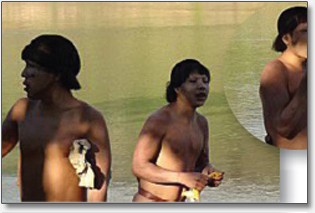Isolated Amazon Tribe Makes First Contact

By Samba Lampich
In June 2014, a group of tribesmen from a previously unknown Brazilian tribe waded across an Amazon river and made their first contact with villagers in 20 years.
First Contact
The group of five young men and two women wore only loin cloths and were armed with bows and arrows. The native group identified as the Rio Xinane, who are part of the Panoan linguistic emerged from their home in the Peruvian rainforest and made contact with Ashaninka local people of northern Brazil.
The Brazilian government's National Indian Foundation (FUNAI) dispatched linguists and health experts to assist the tribe. They told interpreters that they had been attacked and driven from their homes by loggers and drug traffickers. They said some of their relatives had been killed and their homes burned.
Video shows the tribesmen accepting bananas, axes and blades from local villagers. One is also shown handling a gun but it isn't known if he returned to the forest with the weapon.
Driven From Their Homes
It is believed that cocaine-growing gangs and illegal loggers are pushing deep into the Brazilian-Peruvian forest and encroaching on the indigenous tribes' lands and using deadly force to remove them. However, it is not clear if the loggers and traffickers are the main cause driving the tribesmen from their home.
"We do not have this consolidated information, we do not know exactly the reason they had established this specific contact. We believe that with greater communication we can better understand the reasons," said a representative from FUNAI.
Anthropologist Terri Aquino told Brazilian news site G1, "These people are in search of technology. This is important to their lives, because there is an internal "war" between them and the contact with other non-indigenous groups."
A Dangerous New World
But the gangs and loggers are not the only looming danger to the tribe's survival. Contact with the outside world is also perilous as many of the isolated tribes lack immunity to common diseases and are vulnerable to the viruses. Some of those who ventured out to seek help caught a serious respiratory disease, a major killer of isolated indigenous people. They have since recovered but are still at risk, and the governments of Peru and Brazil are warning people to keep away from tribesmen to avoid spreading diseases.
According to Survival International, there are believed to about 100 uncontacted tribes and 77 of these tribes live in Brazil. The group is running a petition calling for better resources to protect indigenous peoples' way of life.
Classroom Discussion
- What other factors, other than loggers or drug traffickers, could affect people who rely on the land for their livelihood?
- Who are thought to be the most genuinely isolated people on Earth and how have they maintained this isolation?